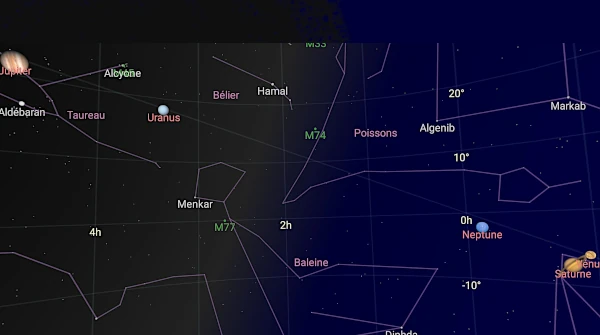
Image description: Alignment of five planets, Jupiter (top left), Uranus, Neptune, Saturn, Venus (bottom right) was visible in January 2025 after sunset. Image source: astronoo.com
The term "Planet Alignment" evokes a striking image of all the planets in our solar system perfectly aligned like marbles on a stick. However, the reality is a bit more nuanced.
A planet alignment is an Astronomical Phenomenon where several planets in the solar system appear aligned when observed from Earth. This alignment does not mean that the planets are perfectly in a line in space, but that they are close to each other in the same region of the sky.
Astronomers call this an "Apparent Conjunction," as the planets, though millions of kilometers apart, seem close due to their relative positions in their orbits.
A visual illusion: In reality, the planets are never perfectly aligned in a perfectly flat plane. Their orbits are slightly inclined relative to each other. What we perceive as an alignment is rather a configuration where several planets are in the same region of the sky, as seen from Earth.
A relative phenomenon: The alignment depends on the observer's point of view. An alignment seen from Earth will not be the same when viewed from another planet.
The planets of the Solar System orbit the Sun in planes relatively close to the ecliptic, an imaginary line around which the planets appear to rotate when observed from Earth. There are several types of alignments depending on the number of planets involved and their configuration:
The planets move at different speeds on elliptical orbits. Therefore, there is no regular and predictable cycle for a "perfect" alignment of all the planets. Planet alignments are rare and depend on the synchronization of their orbits. For example, a grand alignment involving several planets may occur once every 100 to 200 years.
Frequent conjunctions: On the other hand, conjunctions of several planets are relatively frequent. These events occur when several planets are in the same region of the sky, offering a magnificent spectacle for observers.
Partial alignments: It is more common to observe partial alignments, involving only a few planets.
Periods when alignments have occurred or will occur, as these events depend on many factors and are complex to predict with great precision. However, many astronomy websites and mobile applications allow tracking celestial events and staying informed about upcoming planetary conjunctions.
August 2024: A morning alignment allowed the observation of Mercury, Mars, Jupiter, Saturn, Uranus, and Neptune.
June 2024: An alignment of Mars, Saturn, and Jupiter was visible to the naked eye.
January 2025: An alignment of six planets (Venus, Mars, Jupiter, Saturn, Uranus, and Neptune) was visible just after sunset.
February 28, 2025: A complete evening alignment of seven planets is predicted, with Saturn, Mercury, Neptune, Venus, Uranus, Jupiter, and Mars.
August 11, 2025: A morning alignment of six planets, including Mercury, Venus, Jupiter, Uranus, Neptune, and Saturn, will be observable.
Planet alignments do not have a direct impact on Earth or humans. However, they are important moments for astronomical observation, allowing the study of orbits, positions, and properties of the planets. They are also culturally and historically significant, inspiring myths and interpretations in many civilizations.
For example, the Mayans and Babylonians attached great importance to celestial alignments, which they often interpreted as omens. Today, these events help raise public awareness of astronomy.
Thanks to modern astronomical simulation tools, scientists can accurately predict planet alignments centuries in advance. These simulations take into account the laws of universal gravitation and complex numerical models to calculate planetary positions. The data obtained is crucial for: